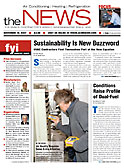
AfterThe NEWSspent months gathering information from conferences that put an emphasis on sustainability and a flurry of published documents on the topic, it concluded that contractors were finding themselves as part of the sustainability equation - first as end users begin asking that energy-efficient and environmentally correct HVACR equipment be installed, and later as governmental regulations eventually require the use of such equipment. The key in 2007 and for 2008 is to be prepared to sell, install, and service such equipment when customers begin asking for it or the government begins requiring it.
“I personally believe that sustainable construction and green market opportunities make up the most critical issue facing our members today,” said David J. Kruse, president of L. J. Kruse Co. of Berkeley, Calif., and president of the Mechanical Contractors Association of America (MCAA). “It is becoming clear that it may well become a part of the single most important issue of this century.”
The American Society of Heating, Refrigerating and Air-Conditioning Engineers (ASHRAE) defined sustainability as “providing for the needs of the present without detracting from the ability to fulfill the needs of the future.” In effect, it means building buildings with mechanical equipment that is energy efficient and leak tight today to avoid that equipment having a negative affect on energy supplies and the environment now and in the future.
Building owners on the HVAC side and supermarket decision makers on the refrigeration (as well as HVAC) side appeared to have taken the lead in sustainability issues. Tom McIntyre, senior manager for resource conservation and environmental stewardship for SuperValu Inc., said a survey done by the Food Marketing Institute showed 67 percent of its members already implemented sustainability practices while another 30 percent planned to do so. He said stores did so primarily for cost reductions and customer-community relations. Of note to HVACR contractors, the primary target area for such cost savings and good public relations was with energy-related matters.
On the HVAC side, hundreds of major projects have been undertaken in recent years in commercial buildings that fit into the sustainability framework. Debate arose as to when all the talk about sustainability would really catch on with end users. According to a report called “The Greening of Corporate America” published by McGraw Hill-Siemens, “Based on projections, green building will reach a tipping point in 2009.”
While companies like Wal-Mart seem to be in the lead, others aren’t quite there yet - although they could very well be close to making the commitment, according to the report. “Many companies agree that greening their existing buildings - an important element to reducing the environmental impact of the built environment - is not difficult, though there remains room for education.” At the same time, the report noted, “There are many market indicators that suggest green construction will continue to grow - and grow quickly - in the next decade.”
Prediction warnings were issued this past year, however, forecasting that the entire sustainability issue would eventually be driven more by governmental regulations than by “doing the right thing.”
The McGraw Hill-Siemens report suggested contractors look to owners of smaller buildings as the first front to offer upgraded equipment. In a 2006 survey, it was noted that at that time, “Twenty-five percent of building owners thought compliance with green building standards would eventually be required by law. Smaller companies tended to believe most strongly in green becoming a standard.”
Publication Date:12/24/2007

Report Abusive Comment